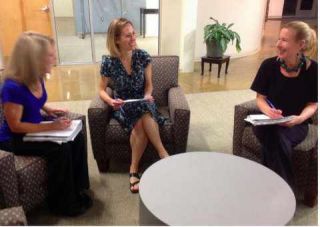Meditation
How to See Yourself More Clearly
The healing power of meditation and writing
Posted May 22, 2015
I spend most of my days rushing along on the surface of life in a succession of appointments, meetings, deadlines and challenges that feels like an agility course.

But my daily meditation brings me back in touch with myself and writing in my journal reveals a world of inner conflicts, insights, and possibilities lying deep beneath the surface. In fact, writing about our lives can be a form of therapy. Psychologist James Pennebaker has found that writing about our personal challenges and conflicts can relieve our suffering and bring us new perspectives on our lives (Pennebaker, 1990).
Holly Makimaa, interfaith minister, teacher, and workshop leader, sees a powerful synergy between writing and meditation. “Meditation expands our consciousness and makes us more awake,” she said in a recent interview, “and journaling helps us to process the concrete particulars of our awakening.” Combining the two in her classes, workshops and retreats, she sees writing as a spiritual practice that brings people greater insight. “Writing can help us to look at our shadow side and discover the hidden golden shadow of ourselves.”

Our “golden shadow,” she explained, represents “the brilliant, strong parts of ourselves we’re unwilling to own.” Many of us have a harder time acknowledging our strengths than our weaknesses. “It’s really quite profound” she said, of students in her workshops. “Family upbringing, culture, and even some religious ideologies don’t allow people to acknowledge the divine in themselves.” She referred to the Dalai Lama’s stunned amazement when he came to this country years ago. He didn’t understand why so many Americans were struggling with feelings of unworthiness because in Tibetan Buddhism there’s this sense of oneness with our divine nature.To help her students get in touch with their strengths, Makimaa asks them to write about about a time when they felt their own power. Seeing their strengths on paper, she says, brings people greater awareness, greater clarity. It’s “like holding up a mirror for them.”
Writing can help us see ourselves more clearly. If you’d like to try this for yourself, take a pencil and paper and set aside some time to:
- Close your eyes, and take a deep breath.
- Focusing on your breathing, gradually relax into a deeper awareness of your body.
- Then open your eyes and write about a time when you felt your power—the first thought that comes to mind. It can be last week, last year, even a scene from your childhood.
- What did it look like and feel like?
- When you’ve finished writing, read what you’ve written,
- Look for your strengths and circle them
- Take a deep breath and breathe in a deeper awareness of these strengths
Then find a way to express your strengths more fully this week.
References
For more information about Rev. Holly Makimaa, see http://www.yourtransformationaljourney.com/ and http://twinstitute.net/summer-sessions-2015/#S115Makimaa
Pennebaker, J. W. (1990). Opening up: The healing power of confiding in others. New York, NY: William Morrow.
***********************************
Diane Dreher is a best-selling author, personal coach, and professor at Santa Clara University. Her latest book is Your Personal Renaissance: 12 Steps to Finding Your Life’s True Calling.
Visit her web site at www.dianedreher.com


